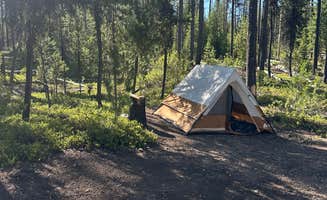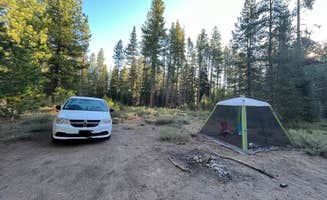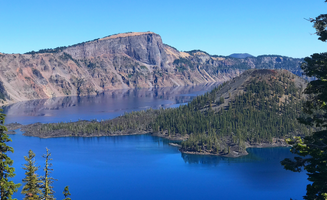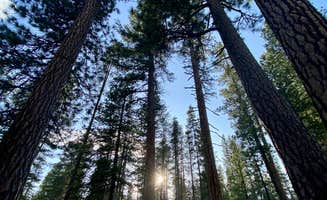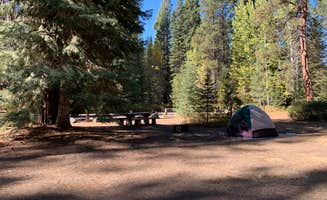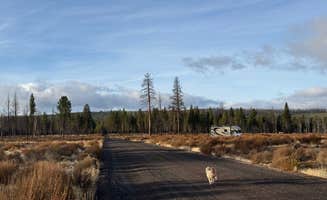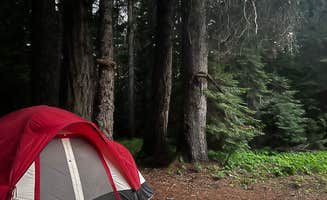Rustic camping near Crater Lake, Oregon offers secluded forest locations typically between 4,500-5,500 feet elevation. The area's volcanic soils create distinctive camping conditions, with pumice-based terrain that drains quickly after rainfall but produces significant dust during dry periods. Forest roads in the region often remain snowy until late May, with campsites at higher elevations becoming accessible later in the season.
What to do
Kayaking at crystal springs: Jackson F. Kimball State Recreation Site provides access to remarkably clear spring-fed waters. A camper noted, "We had brought our kayaks and launched right off the bank. The water was so amazing." The recreation site offers primitive camping with picnic tables and nearby paddling opportunities.
Wildlife watching at dusk: The forests around Mount Thielsen Wilderness host abundant wildlife active during transition periods. "Be aware that there is a lot of wildlife in the area," mentions one visitor. Early morning and evening hours offer the best viewing opportunities, especially along forest edges.
Stargazing from elevated sites: Higher elevation spots provide exceptional night sky viewing with minimal light pollution. "The stars and trees were stunning," reports a camper at Mount Thielsen Wilderness. For the clearest views, seek camping areas away from tree cover, particularly those at ridgeline locations.
What campers like
Forest solitude: The dispersed sites along Forest Road 960 by Pacific Crest Trail provide exceptional privacy. "There was a perfect spot for our van. It was private and there was beautiful scenery all around us," explains a camper who found seclusion among the trees. These sites typically accommodate smaller vehicles and tents rather than large RVs.
Established fire rings: Many dispersed sites feature existing fire rings, especially along Forest Road 960. One visitor mentioned finding "lots of little camp fires scattered around the area," providing ready-made spots for safe fires. Always check current fire restrictions before visiting as bans are common during dry periods.
Overnight flexibility: Thousand Springs Sno-Park serves as a reliable backup when park campgrounds fill. "There is a huge lot that would fit many RVs, easy turnaround and plenty of room to spread out," shares a camper. The paved lot includes vault toilets and additional forest spots nearby for more privacy.
What you should know
Seasonal window constraints: Free overnight parking at sno-parks has specific date restrictions. A camper clarifies, "Note that free overnight parking without a sno-park parking permit is only permitted between May 1 and November 14." Outside these dates, winter permits are required.
Primitive facilities only: Most dispersed sites offer no amenities. "There were no frills with this campground other than the location itself. No restrooms, no running water, nothing!!" explains a visitor to the area. Plan to be completely self-sufficient with water, waste disposal, and supplies.
Bear activity: Wildlife encounters require proper preparation in the Lightning Springs Backcountry Dispersed Campsite area. "While the backcountry campsites do not allow fires, there are other location around Rim Village that have established sites that you can," reports a hiker. Always store food properly as bears frequent the region.
Temperature fluctuations: Even summer nights can be cold at this elevation. "It was pretty cold, even though I went in late June! It was snowing at the campsite but didn't stick," reports one camper. Pack layers and appropriate sleeping gear even during summer months.
Tips for camping with families
Accessible swimming: The spring-fed waters at Jackson F. Kimball State Recreation Site provide a unique swimming experience, though be prepared for cold temperatures. "The water is FREEZING cold!! The cold hurt my ankles after about 5 min. and I had to get out…and this was in August!!" warns a family camper.
Bug protection essential: Insect defense is crucial for comfortable camping with children. "The mosquitos were more aggressive than the bear," noted one parent camping with a toddler. Multiple campers recommend full coverage clothing plus repellent, particularly during evening hours.
Pre-download maps: Lack of connectivity affects navigation throughout the region. A camper suggests, "Save a satellite screenshot beforehand; cell service is weak and layout's tricky." NF-70 Dispersed Camping Near Crater Lake NP offers some of the area's rare cell coverage, with one visitor reporting, "AT&T service was fair with 1-2 bars of LTE and speeds up to about 7 MB/s."
Tips from RVers
Road quality considerations: Forest roads require careful navigation for larger vehicles. "NF-70 is gravel and in pretty good shape, i.e., no potholes, but is heavily washboarded. This wasn't an issue for the Cherokee, but with a stiffer suspension, I had to limit the RV speed to less than 7 mph to keep from shaking it apart," advises a full-timer with a 36-foot Class A.
Level site locations: Several flat sites accommodate large rigs near specific intersections. "Around the intersection of FR 960 and 961, there are lots of big flat sites great for RVs," notes a camper at Forest Road 960 Campsite. The best spots for larger vehicles are typically found near road junctions rather than further into the forest.
Morning condensation management: High elevation camping creates heavy overnight moisture, particularly for RVs. "By dawn, ice lined my windows of my car," reports one camper, highlighting the cold overnight temperatures that can cause significant condensation inside vehicles even during summer months.



